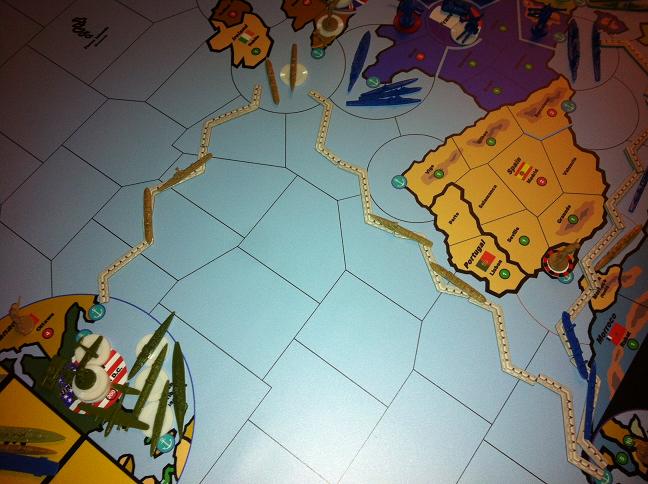I came up with an idea for one on one wars between two powers using the Global 1940 map. Here are the instructions for two versions (Soviet Union vs US and Germany vs Japan):
Common rules:
All other powers are neutral. No pro-Axis or pro-Allied neutrals are involved on either side. Attacking true neutrals is allowed with the usual effects of them siding with the other enemy of the attacker. Only territory of the belligerents (with exceptions detailed below) may be crossed.
For TripleA, use edit mode to make all powers neutral, including pro-Axis and pro-Allies.
An optional rule is to make pro-Axis and pro-Allied territories also true neutrals.
One side wins when all the units of the other side have been destroyed and all the territory of the enemy has been conquered.
Japan vs Germany:
To make the game faster, Trans-Jordan and Egypt will be under Japanese control and Gibraltar is under German rule.
All starting units and income is the same (Japan’s starting IPCs are still 26 even with the addition of Egypt and Trans-Jordan and the income effects of these two territories will only start at turn 2).
For TripleA, edit mode can be done to change the territories to their correct owners.
Additionally, Germany’s 10 IPC national objectives that are achieved (Iron Ore and Soviet trading) are kept, and no other national objectives are changed.
Japan’s trade with the US 10 IPC national objective is also kept.
For TripleA, edit mode is necessary for the US to be recorrected to be neutral as the US automatically declares war on turn 3.
Soviet Union vs US:
All starting units and income are the same.
The Soviets control Denmark, and like above the income change only applies starting at turn 2.
The US does not get their “at war” national objectives. This means that the US will only ever get 52 IPCs per turn until the US conquered Soviet territory.
Edit mode is required to make the US neutral with the Axis because the US automatically declares war on them at turn 3 for TripleA.
Soviet national objectives are the same. Due to not fighting the Axis, the Soviets will not achieve any. This intentional.
Remember to use edit mode to make all relationships between powers neutral.
Here are two test games I played on TripleA (TripleA is required to access these files) for both of these ideas. Keep in mind that since these were tests, what was done there may be inconsistent with what I outlined here, which are the definitive and final versions of the rules. Keep in mind I also used edit mode to change unit buys and to correct movement, but no moves or purchases were illegal. They might also give you some ideas of strategies.









 _The Conflict is a global-strategy based game designed around the economic and military conditions of Europe in 1914. Players play in one of two alliances, The Central Powers or The Allied Powers, to defeat their opponents. Players choose among seven nations (Austria-Hungary, Germany, Great Britain, France, Italy, Ottoman Empire, and Russia). After selecting a nation, players take turns completing their objectives during each round.
_The Conflict is a global-strategy based game designed around the economic and military conditions of Europe in 1914. Players play in one of two alliances, The Central Powers or The Allied Powers, to defeat their opponents. Players choose among seven nations (Austria-Hungary, Germany, Great Britain, France, Italy, Ottoman Empire, and Russia). After selecting a nation, players take turns completing their objectives during each round. The Conflict has been extensively tested and designed by gamers for gamers. Players will take their turn each round to strengthen their tactical advantages and defend the borders of their nation. Each turn is broken down into Phases. Players must complete each previous phase in order to proceed onward with the rest of their turn. If a player decides to enter into combat with another player, they must, along with their opponent, roll a set number of D12 dice to determine the outcome of each individual battle. The Conflict uniquely deducts a combat penalty from the player with the weakest military strength in a territory. This combat penalty is taken off all of their dice rolls during the individual combat. The combat penalty allows for the strongest opponent to have a real-world advantage over their enemy, if they have a larger military presence in the area. Players can develop multiple (land, naval, and air) strategies to succeed. They can utilize 11 military units with unique capabilities to complete specific goals, upgrade technology, play one of three victory scenarios, as well as try a variety of player preferences.
The Conflict has been extensively tested and designed by gamers for gamers. Players will take their turn each round to strengthen their tactical advantages and defend the borders of their nation. Each turn is broken down into Phases. Players must complete each previous phase in order to proceed onward with the rest of their turn. If a player decides to enter into combat with another player, they must, along with their opponent, roll a set number of D12 dice to determine the outcome of each individual battle. The Conflict uniquely deducts a combat penalty from the player with the weakest military strength in a territory. This combat penalty is taken off all of their dice rolls during the individual combat. The combat penalty allows for the strongest opponent to have a real-world advantage over their enemy, if they have a larger military presence in the area. Players can develop multiple (land, naval, and air) strategies to succeed. They can utilize 11 military units with unique capabilities to complete specific goals, upgrade technology, play one of three victory scenarios, as well as try a variety of player preferences.












